Discrete HTPC GPU Shootout
by Ganesh T S on June 12, 2011 10:30 PM ESTWe ran the DXVA Checker benchmark on all the cards, but our graphing engine allows us to present only four series in each graph. This meant that we had to choose between the GDDR5 based AMD 6450 and the DDR3 based MSI 6450. Keeping in mind our focus on passively cooled GPUs, we went with the latter. It was observed that the 'No VPP (Video Post Processing)' frame rates were similar for both the candidates. However, as post processing algorithms were enabled, the MSI 6450 began to perform a bit worse than the AMD 6450. We will analyze the probable cause later. We were able to get DXVA2 acceleration with the EVR renderer for all codecs except the MPEG-4 variants.
First, we look at a 1080p H.264 clip. The MPC Video Decoder v1.5.2.3134 was able to playback the clip without issues on all the GPUs. There were a couple of surprises in store when the DXVA Checker benchmark (as described in the previous section) was run.
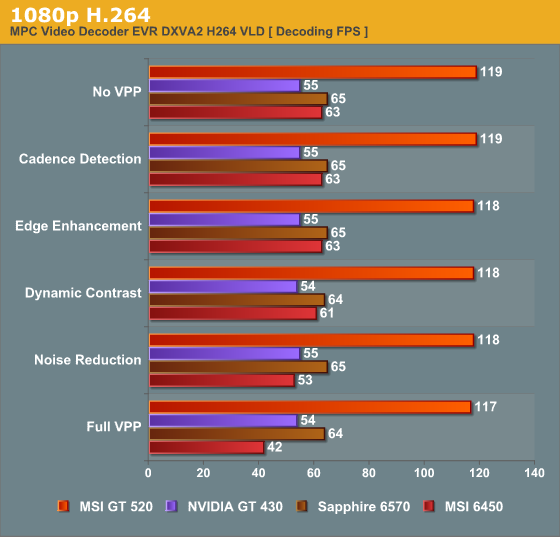
While the GT 430 was unable to reach the magical 60 fps benchmark figure (I expect any GPU worth its salt to be able to decode 1080p60 H264 clips), the GT 520 sprang a surprise with some insane decoding speeds. Even considering the fact that the GT 520 took shortcuts by skimping on the post processing, it comfortably beats every other GPU in the race. The 430's benchmark result was even more puzzling, considering the fact that all the 1080p60 AVCHD and re-encoded broadcast clips that we threw at it played back flawlessly. We talked to NVIDIA about this, and it looks like the culprit in this case was the bitrate. Our sample was a 40 Mbps clip at 1080p30. At 60 fps, the VPU engine would have had to process a sample at 80 Mbps, and apparently, the VP4 engine in the GT 430 is simply not capable of that. We are willing to cut NVIDIA some slack here, because I have personally not seen any real 1080p60 content at 80 Mbps. We will cover both of the above aspects in detail in the next section.
With the exception of the 6450, we find that enabling various post-processing options doesn't bring down the decode frame rate. This shows that the latency of the post processing steps is completely hidden by the time spent in the UVD / VPU engines to obtain the decoded frame. For the 6450, we infer that the lower core clock for the stream processors slows down the post processing steps a bit too much.
For the 1080p VC-1 clip, we again use MPC Video Decoder v1.5.2.3134 for flawless play back.
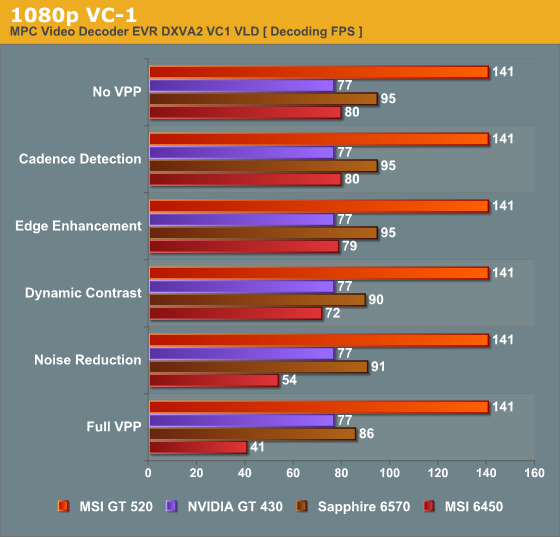
We find that the NVIDIA GPUs hide their post processing latency in the time taken by the VPU engine. However, the 6570 shows a gradual decline in the throughput as various options are enabled. The decline is not as alarming as the 6450's, and manages to comfortably stay above 60 fps.
VLD acceleration for MPEG-2 was only recently introduced in the UVD 3 engine by AMD. The Microsoft DTV-DVD Video Decoder is able to provide DXVA2 acceleration for MPEG-2 clips.
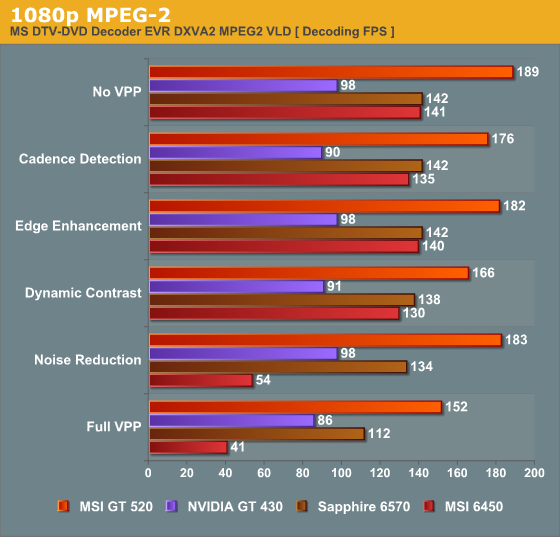
It is not clear why turning on deinterlacing / cadence detection should affect the throughput of the decode of the progressive clip, but that is what we observe for all the candidates except the 6570. Compared to VC-1 and H.264 decoding which decided the throughput of the video pipeline, MPEG-2 is much easier on the UVD / VPU engine. This is reflected in the fact that the video post processing brings down the throughput quite a bit on all the GPUs.
Moving onto interlaced streams, we will consider a 1080i H.264 clip first.

As expected, deinterlacing definitely kicks in to lessen the throughput of the frames. Unlike the 1080p H.264 decode performance, we find that all the GPUs are now limited by how fast the post-processing can be done. This makes sense, since the UVD/VPU engine needs to operate for only half the usual horizontal resolution for interlaced content. Note that the 'frames per second' figure presented for the interlaced streams is actually 'fields per second' (a 1080i clip showing 29.97 fps with MediaInfo actually has 59.94 fields per second).
The interlaced MPEG-2 performance is as below:
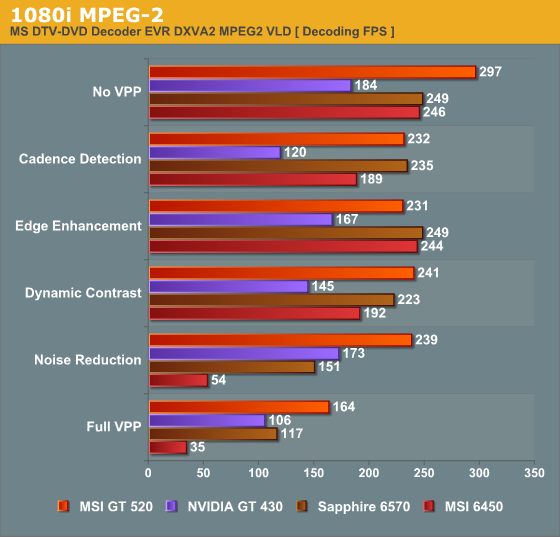
Results are very similar to what we got for the interlaced H.264 clip. One can conclude that interlaced clips spend more time getting post-processed compared to the progressive clips, but that is hardly surprising.
We had noted earlier that DXVA2 / EVR wasn't enabled for interlaced VC-1 streams on any of the GPUs. However, with the checkactivate.dll hack (described in the LAV Splitter section), we were able to make Arcsoft Video Decoder appear in the list of codecs when the 'Check DirectShow / MediaFoundation Decoders' was used for interlaced VC-1 clips. Though it wasn't explicitly indicated that the support was DXVA2 using EVR, we did find that playing back the stream using EVR consumed almost nil CPU resources and kept the GPU / VPU engine quite busy. Presented below is the interlaced VC-1 performance using the Arcsoft Video Decoder in Total Media Theater v5.0.187
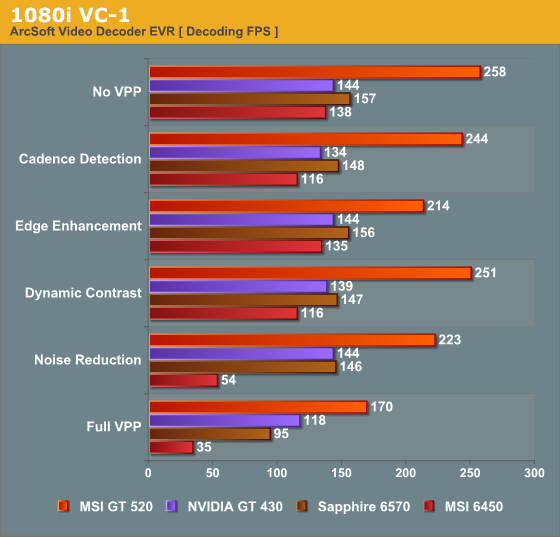
The takeaway from this section is that cards which run too close to the 60 fps limit with all post processing steps enabled should be avoided, unless there are some convincing reasons for that. The results also need to be taken in conjunction with the day-to-day usage experience. As mentioned before, the 6450 fails on both counts. The GT 520 fails the day-to-day usage test (deinterlacing performance). The GT 430 gets a recommendation despite weighing in at less than 60 fps for the 1080p H.264 stress stream. The 6570 is the hands down winner in this section. It is able to carry out all the post processing steps even when it is forced to process very stressful video streams.










70 Comments
View All Comments
ganeshts - Thursday, June 16, 2011 - link
PotPlayer apparently doesn't have support for hardware deinterlacing, and has a host of other issues [ Search for PotPlayer in this page and then read the next set of posts about it : http://www.avsforum.com/avs-vb/showthread.php?p=20... ].Of course, if it works for you, it is great :) (probably it is a good solution for people watching progressive material only).
The author of LAV CUVID talks in that thread about how renderless DXVA mode works with madVR at the cost of deinterlacing.
Btw, there is no decode of DTS-HD in any open source software now. Both ffdshow and PotPlayer can decode only the core DTS soundtrack. DTS decode has been around for a long time, though.
NikosD - Saturday, June 18, 2011 - link
Indeed, I was referring to progressive material only - interlaced material is rare - but the page you mentioned says PotPlayer has CPU deinterlacing.I don't see where is the problem.
Hardware Deinterlacing is less important - for most users - than Hardware Decoding (DXVA) and less important than the UNIQUE capability of using DXVA + madVR at the same time.
The cost of hardware deinterlacing is nothing compared to the cost of DXVA and madVR.
For the audio part of your answer, I have to say that because of my AVR (Pioneer VSX-920) decoding inside a PC, BluRay, Media Player or any other decoding capable device of multi-channel audio is never an option for me.
I always prefer the bitstreaming solutions for multi-channel audio - as most of the owners of AVR do - like those provided by FFDshow and PotPlayer which both are more than capable of providing them.
That's why I wrote "decoding and pass-through", I had to write "splitting and pass-through".
One last word.
For every piece of software out there, there is always a list of changes, bugs, things to do.
That doesn't mean we don't use it or like it.
PR3ACH3R - Friday, June 17, 2011 - link
@Ganesh T S,This is some NICE work.
In fact, I cannot recall when was the last time I have seen such an in depth article on the HTPC GPU subject in Anandtech.
The balance between the technical issues, the background, & the effort to honestly report all issues known to you in this article, is spot on.
If it is missing something on the issues report, it misses on the ATI/AMD DPC Latency spiking issues.
As this is still remains unnoticed in Anandtech even in this excellent article, here is a link to the AVS post describing it.
http://www.avsforum.com/avs-vb/showthread.php?t=12...
(Ignore some of the discredit attempt posts in this thread, this problem exists to this very day.)
NikosD - Thursday, June 23, 2011 - link
Well, I did some further tests and found out that PotPlayer does have hardware deinterlacing.Have you done any tests by yourself to see if the player supports Hardware Deinterlacing ?
ganeshts - Saturday, June 25, 2011 - link
NikosD, I will definitely try PotPlayer out in the next GPU review. Till now, my knowledge is limited to what is there in the AVSForum thread.flashbacck - Friday, June 24, 2011 - link
I know HTPCs are even more of niche these days than ever, so I appreciate you still doing these tests very much.wpoulson - Thursday, July 28, 2011 - link
I really appreciate this guide and have been stepping through itI just registered the ASVid.ax file from TMT5 but the filter is not showing up in the External Filter section of MPC-HC. At first I thought it might be because I registered it on the 32 bit side and I'm using 64 bit MPC-HC, so I unregistered the file from System 32 and registered it on the 64 bit side.
I registered it by going to Start>CMD>Cntrl-Shift-Enter and using the "Regsvr32" command to register the file. I put the file along with the checkactivate dll in a folder in the root directory of my C drive and pointed the Regsvr command to the ASVid.ax file. After hitting enter, I received a "dll successfully registered" message.
Can someone help me to get the filter visible for MPC-HC?
A question...While it's considered beta, will the new LAV video decoder do the same thing the arcsoft video decoder does?
Thanks
Warren
stuartm - Friday, January 20, 2012 - link
I am aware the gt 430 is a good choice to work around the infamous WMC 29/59 framerate bug. Can you comment on whether or not the 6570 will stutter or not when playing content with 29/59 framerate problems? A very important consideration for those of us using ceton or HDHR Primes (or the new Hauppauge box) for cable TV Live viewing and record/replay.Thank You
MichaelSan1980 - Saturday, January 21, 2012 - link
I'd use my HTPC for DVD's and BD's only with an Full-HD TV. Since i have a rather strong CPU and wouldn't use Hardware Deinterlacing for DVDs, i wonder, if the GT520 is ~that~ bad, in terms of image quality?drizzo4shizzo - Wednesday, June 20, 2012 - link
Old guy here.In the market but I need confirmation that these cards can do component output to "old guy" HDTV.
NONE of the marketing materials suggest that any recent card can.
Meaning they either come with a component video breakout or at least are compatible with a known 3rd party product, and that they can do the RGB -> YUV thing.
This ancient EVGA 7600 GT I have does it... with an "svideo lookalike" 7 pin -> component breakout.
Anyone? Beuller?